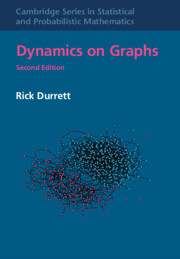Refine search
Actions for selected content:
52341 results in Statistics and Probability
Analysis of influencing factors of concurrent primary liver cancer in hepatitis B patients and construction of column chart prediction model
-
- Journal:
- Epidemiology & Infection / Volume 153 / 2025
- Published online by Cambridge University Press:
- 16 September 2025, e111
-
- Article
-
- You have access
- Open access
- HTML
- Export citation
Modeling discrete common-shock risks through matrix distributions
-
- Journal:
- ASTIN Bulletin: The Journal of the IAA , First View
- Published online by Cambridge University Press:
- 16 September 2025, pp. 1-26
-
- Article
- Export citation
Building Information Graphs (BIGs): remodeling building information for learning and applications
-
- Journal:
- Data-Centric Engineering / Volume 6 / 2025
- Published online by Cambridge University Press:
- 15 September 2025, e44
-
- Article
-
- You have access
- Open access
- HTML
- Export citation
Uncovering policy priorities for disability inclusion: NLP and LLM approaches to analyzing CRPD state reports
-
- Journal:
- Data & Policy / Volume 7 / 2025
- Published online by Cambridge University Press:
- 15 September 2025, e61
-
- Article
-
- You have access
- Open access
- HTML
- Export citation
Using graph neural networks and frequency domain data for automated operational modal analysis of populations of structures
-
- Journal:
- Data-Centric Engineering / Volume 6 / 2025
- Published online by Cambridge University Press:
- 15 September 2025, e45
-
- Article
-
- You have access
- Open access
- HTML
- Export citation
The structure of identity facilitation and interference
- Part of
-
- Journal:
- Network Science / Volume 13 / 2025
- Published online by Cambridge University Press:
- 15 September 2025, e12
-
- Article
-
- You have access
- Open access
- HTML
- Export citation
Industrial mobile robot-based manufacturing system modeling potential
-
- Journal:
- Data-Centric Engineering / Volume 6 / 2025
- Published online by Cambridge University Press:
- 15 September 2025, e46
-
- Article
-
- You have access
- Open access
- HTML
- Export citation

Dynamics on Graphs
- Coming soon
-
- Expected online publication date:
- September 2025
-
- Book
- Export citation
An explicit economical additive basis
- Part of
-
- Journal:
- Combinatorics, Probability and Computing , First View
- Published online by Cambridge University Press:
- 12 September 2025, pp. 1-6
-
- Article
-
- You have access
- Open access
- HTML
- Export citation
Response to letter to editor from Rattanapitoon, N. & Rattanapitoon, S
-
- Journal:
- Epidemiology & Infection / Volume 153 / 2025
- Published online by Cambridge University Press:
- 12 September 2025, e100
-
- Article
-
- You have access
- Open access
- HTML
- Export citation
Cyber breach risk modeling for insurance: capturing temporal and cross-group dependence
-
- Journal:
- Annals of Actuarial Science , First View
- Published online by Cambridge University Press:
- 12 September 2025, pp. 1-25
-
- Article
-
- You have access
- Open access
- HTML
- Export citation
Letter to the Editor: “Modelling the risk of foodborne transmission of Toxocara spp. to humans” by Healy et al. (2025)
-
- Journal:
- Epidemiology & Infection / Volume 153 / 2025
- Published online by Cambridge University Press:
- 12 September 2025, e101
-
- Article
-
- You have access
- Open access
- HTML
- Export citation
Modeling the influences of climate conditions on measles transmission in China
-
- Journal:
- Epidemiology & Infection / Volume 153 / 2025
- Published online by Cambridge University Press:
- 11 September 2025, e110
-
- Article
-
- You have access
- Open access
- HTML
- Export citation
Conditioning Bienaymé–Galton–Watson trees to have large sub-populations
- Part of
-
- Journal:
- Advances in Applied Probability , First View
- Published online by Cambridge University Press:
- 10 September 2025, pp. 1-42
-
- Article
- Export citation
Quasi-stationary distributions for subcritical branching Markov chains
- Part of
-
- Journal:
- Advances in Applied Probability , First View
- Published online by Cambridge University Press:
- 10 September 2025, pp. 1-47
-
- Article
- Export citation
Large and moderate deviations in Poisson navigations
- Part of
-
- Journal:
- Advances in Applied Probability , First View
- Published online by Cambridge University Press:
- 10 September 2025, pp. 1-38
-
- Article
-
- You have access
- Open access
- HTML
- Export citation
Well-posedness and averaging principle for non-Gaussian McKean–Vlasov stochastic differential equations with locally Lipschitz coefficients
- Part of
-
- Journal:
- Advances in Applied Probability , First View
- Published online by Cambridge University Press:
- 09 September 2025, pp. 1-44
-
- Article
-
- You have access
- HTML
- Export citation
Asymptotic mixed normality of maximum-likelihood estimator for Ewens–Pitman partition
- Part of
-
- Journal:
- Advances in Applied Probability , First View
- Published online by Cambridge University Press:
- 09 September 2025, pp. 1-21
-
- Article
-
- You have access
- Open access
- HTML
- Export citation
The distance on the slightly supercritical random series–parallel graph
- Part of
-
- Journal:
- Advances in Applied Probability , First View
- Published online by Cambridge University Press:
- 09 September 2025, pp. 1-42
-
- Article
-
- You have access
- Open access
- HTML
- Export citation
On orderings of vectors of order statistics and sample ranges from heterogeneous bivariate Pareto variables
-
- Journal:
- Probability in the Engineering and Informational Sciences , First View
- Published online by Cambridge University Press:
- 09 September 2025, pp. 1-16
-
- Article
-
- You have access
- Open access
- HTML
- Export citation

































